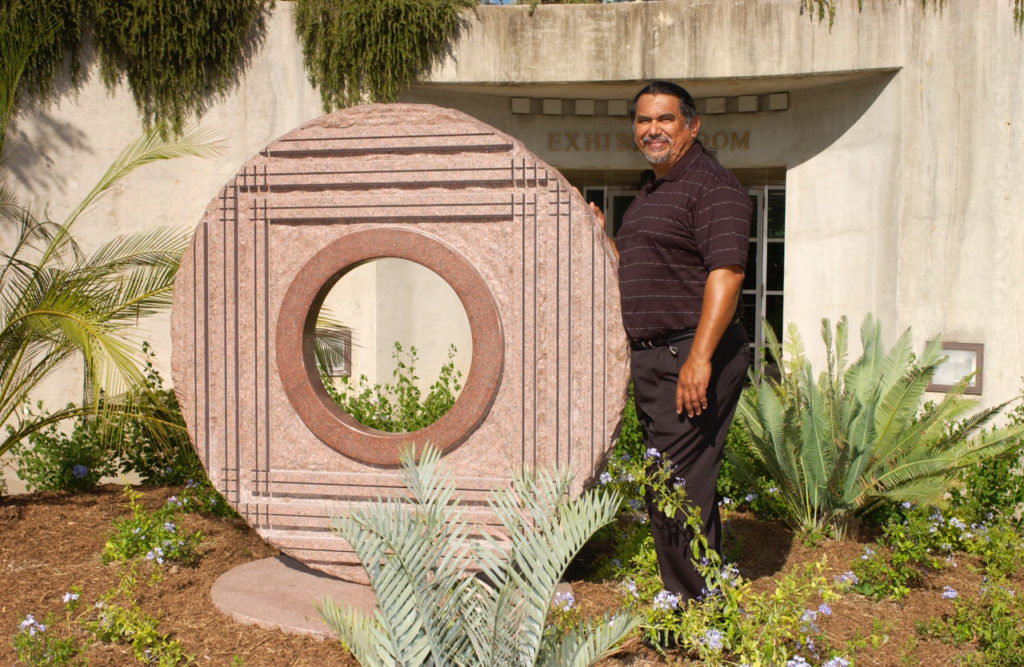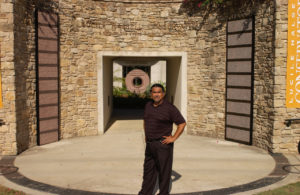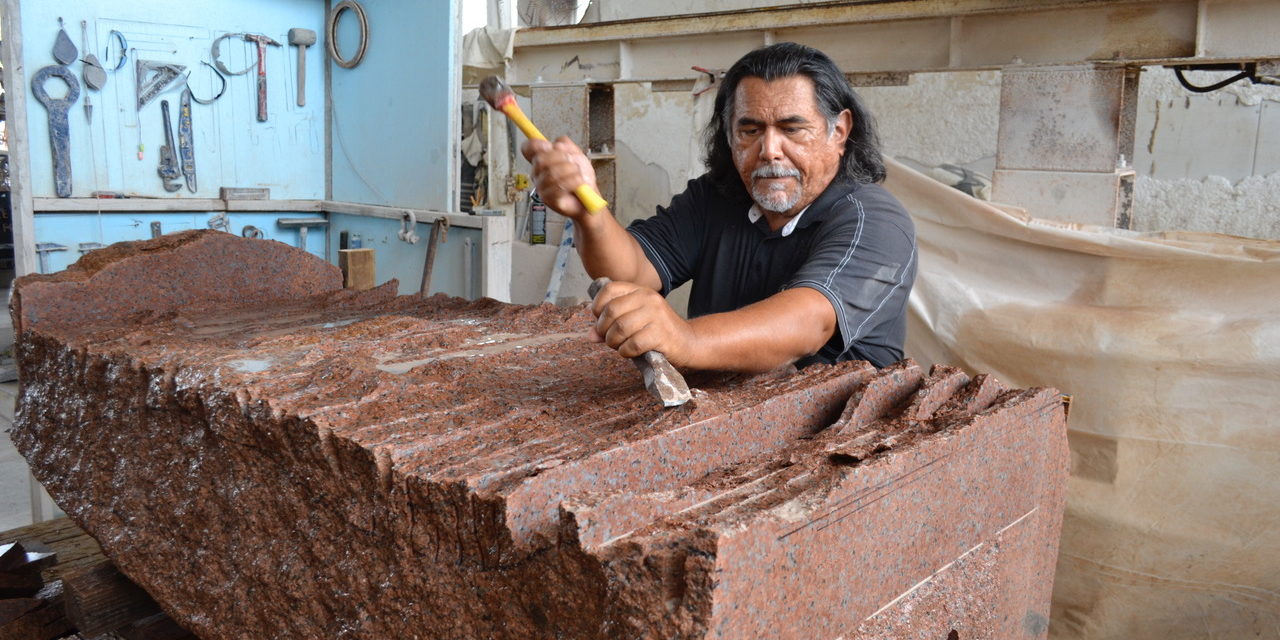By Dr. Ricardo Romo
During his life as an artist, Jesus Morales received many important commissions for his granite sculptures. Over a thirty-four year career, he completed more than 2,000 art pieces throughout the world.
Unlike many artists who realize their dream of artistic creativity after many years of experimentation and growth, Moroles became one of America’s most famous granite sculptors simply by walking away from the traditional style and method favored by the Renaissance artists who had inspired the art world for over four centuries.

Moroles at the SA Botanical Gardens Exhibition 2007. Photo by Ricardo Romo
When young Jesus was ten years old, his dad, Jose Moroles, enrolled him in art classes at the YMCA and drove him to his classes. Moreover, with the intent of having his son learn the building and concrete trades, Jose Moroles also encouraged his son to work during his summer vacation months with his uncle Julian Tapia who had been hired by the city to work in the construction of the Corpus Christi seawalk.
In 2010 my wife and I had an opportunity to visit Moroles and his family at his Rockport, Texas studio. We talked to his father who had emigrated from Mexico in the 1940s and had become a U.S. citizen in 1953. As we walked around the large three acre studio his father commented that Moroles’ teachers had always encouraged his son to be an artist and had often praised his artistic talents.
Growing up, Jesus loved to draw and paint and as a teen engaged in silk screen printing. Like many young men living in the border region during the Vietnam era, he was drafted. He served four years in the Air Force. His military service enabled him to use his G.I. Bill benefits to attend college at North Texas State University in the mid 1970s.

Moroles at his Rockport Studio. 2011. Photo by Ricardo Romo
Moroles credits an internship with famed artist Luis Jimenez in 1978-1979 as one of the defining moments in his career. At the time, there were only a few Latino artists working in stone, and although Jimenez was creating works of fiberglass, Moroles learned that sculpture had many dimensions.
Over the period 1979-1980, Moroles spent time in Tuscany, Italy with the intent of visiting the famous Pietrasanta quarry that his hero Michaelanglo discovered as well as studying Renaissance sculptures. Moroles was inspired by the genius of Michaelangelo and others who in the 16th century contributed to the Vatican marble statues and tombs. At Pietrasanta quarry in Tuscany, he experienced only disappointment. Michaelangelo may have well preferred the white marble stone of Tuscany, but Moroles considered the stone far too soft for his likings. He returned to the United States determined to find the power tools and diamond saws that would allow him to work with granite, one of the world’s hardest stones.
He arrived back in Texas in 1980 and quickly acquired pink granite for his first stone sculpture. He was pleased with his completion of “Fountain,” a sculpture that incorporated water and stone. His early sculptures won him a commission for an enormous art piece for the CBS Plaza in New York City. His new power tools and diamond saws proved their worth as he completed “Lapstrake,” a 64 ton, 22 foot tall sculpture that resides now in the CBS Plaza.
Writing in 2007, photographer Wally Gobetz wrote: “Moroles’s sculpture is made of perfectly
rectangular slats that bisect two formless
columns–geometry meeting amorphousness.
The term lapstrake actually means clinkerbuilt–
a method used by the Vikings, the Tang
Chinese, and the Song Chinese in the nineteen century for constructing hulls of boats and ships by fixing
wooden planks and iron plates to each other so that the planks overlap along their edges.
In 1982 Moroles returned to the Gulf Coast and built his sizeable studio in Rockport, a short distance from his birthplace. “Granite Weaving,” a sculpture which Moroles completed in 1988, is a spectacular work of cut stone measuring over six feet in height and nine feet in width. In 1996, the Smithsonian American Art Museum acquired it.
Upon seeing the “Granite Weaving” sculpture at the East Wing of the Smithsonian American Art Museum in Washington, D.C. several years ago, I was amazed at this extraordinary creation in which Moroles succeeded in making Georgia gray granite look like Mexican or Native American cloth weaving. The Smithsonian Gallery description reads that “Although he [Moroles] spoke in terms of fabric, Granite Weaving also reads as the wall of a stepped pyramid in which horizontal stone slabs support, and in turn, are buttressed by small blocks of granite.”
In the mid 1980s the City of Houston began a fundraising campaign to honor police officers who had lost their lives in the line of duty. The City of Houston chose Moroles’ concept for the police memorial and he began this work in the late 1980s. He managed to complete the “Houston Police Officers Memorial” in 1990. For this structure, he designed “a granite square pyramid whose vertex rises from the meadow, surrounded by four inverted pyramids excavated from the ground.” The top of the pyramid contains a pink granite reflecting pool engraved with the names of over 100 officers killed in the line of duty. The memorial is 120 feet by 120 feet, one of the largest art structures created by a Latino artist.

Moroles at the SA Botanical Gardens Exhibition. 2007.
Photo by Ricardo Romo
Today, this memorial has become a popular gathering place for residents from the nearby Houston Buffalo Bayou neighborhoods. By 2002, when the Fine Arts Museum in Houston had a major showing of Moroles’ sculptures, his works were already collected by museums in the United States, Europe, and Asia.
When we visited Moroles’ studio in Rockport in 2011 we were amazed at the collection of large uncut
granite, large cranes, and industrial saws in his outdoor
space. At the time, he held commissioned contracts for
sculptures in Asia, Europe, and the Middle East. In
numerous works from around the country, Moroles
managed to combine North American abstract
architectural style with ancient Mexican construction:
a confluence of two cultures.
Peter C. Marzio of the Houston Museum of Fine Arts wrote that “Ritual also echoes from the works of art themselves. More often than not, Moroles’ sculptures seem as though they are descended from the works of ancient mound builders, sawed and carved and blasted from the earth.” Moroles’ prodigious and creative labors earned him a National Medal of Arts in 2008 awarded by President George W. Bush. At the time of his tragic and premature death in 2014, Moroles had succeeded in establishing himself as one of the premier American sculptors as well as a leading interpreter of Latino culture and society.






